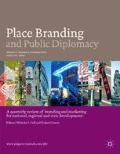Abstract
Marketing and branding of countries, as mentioned in the theoretical and professional literature, is not an easy challenge; this challenge is even more daunting when a certain country has been the subject of prolonged negative media coverage focusing on wars, terror and violence. Using the multistep model for altering place image, this article sets out to analyze strategies used to restore Israel's positive image. The analysis of Israel's image and its marketing efforts can help us better understand how marketers manage nation branding and marketing efforts during prolonged crises and constant conflict. This article is based on a close analysis of dozens of advertisements, public relations (PR) campaigns, press releases, academic and popular articles, news articles, interviews and websites of Israel's government departments and Jewish organizations. The analysis shows that over the years, the nation's marketers used three kinds of strategies: focusing on the source, on the message and on the target audience. The article also evaluates the employment of these various strategies used by Israel's marketers over the years.
Similar content being viewed by others
References
Anholt, S. (2005) Brand New Justice: How Branding Places and Products Can Help the Developing World. Oxford: Elsevier.
Anholt, S. (2006, 2008) Public diplomacy and place branding: Where's the link? Place Branding and Public Diplomacy 2 (4): 271–175.
Anholt, S. (2008) Place branding: Is it marketing, or isn’t it? Place Branding and Public Diplomacy 4 (1): 1–6.
Avraham, E. (2000) Cities and their news media image. Cities 17 (5): 363–270.
Avraham, E. (2006) Public relations and advertising strategies for managing tourist destination image crises. In: Y. Mansfeld and A. Pizam (eds.) Tourism and Security: A Case Approach. London: Butterworth Heinemann, pp. 233–249.
Avraham, E. and Ketter, E. (2008a) Media Strategies for Marketing Places in Crises: Improving the Image of Cities, Countries and Tourist Destinations. Oxford, England: Butterworth Heinemann.
Avraham, E. and Ketter, E. (2008b) Will we be safe there? Analyzing strategies for altering places’ unsafe images. Place Branding and Public Diplomacy 4 (3): 196–204.
Bard, M. (2005) The Complete Idiot's Guide to Middle East Conflict, 3rd edn. New York: Alpha books.
Beirman, D. (2003) Restoring Tourism Destinations in Crisis: A Strategic Marketing Approach. Wallingford, Connecticut: Cobi Publishing.
Coaffee, J. and Rogers, P. (2008) Reputational risk and resiliency: The branding of security in place making. Place Branding and Public Diplomacy 4 (3): 205–217.
Dinnie, K. (2008) Nation Branding: Concepts, Issues, Practice. Oxford, England: Butterworth Heinemann.
Elizur, J. (1987) National Images. Jerusalem: Hebrew University.
Galloway, C. (2005) Hot bullets, cool media: The Middle East's high stakes media war. Journal of Communication Management 9 (3): 233–245.
Gerstenfeld, M. and Green, B. (2004) Watching the pro-Israel media watchers. Jewish Political Studies Review 16 (3–4): 1–24.
Gilboa, E. (2000) Mass communication and diplomacy. Communication Theory 10: 290–294.
Gilboa, E. (2006) Public diplomacy: The missing component in Israeli foreign policy. Israel Affairs 12 (4): 715–747.
Ha'artez . (2000) The tourism ministry will invest three million dollars in the US campaign, 21 December.
http://www.goIsrael.com, accessed 27 June 2008.
http://www.mfa.gov.il, accessed 2 June 2008; http://www.tourism.gov.il; accessed 10 May 2008; http://www.aifl.org, accessed 27 July 2008; http://www.Israel21c.net, accessed 5 July 2008; http://www.ynet.org.il, accessed 4 April 2008.
Hassman, R. (2008) The Israel Brand: Nation Marketing Under Constant Conflict. Tel Aviv, Israel: Tel Aviv University.
Israeli. (2006) Japanese sumo wrestlers will promote tourism to Israel. 14 May.
Katz, M. (2008) The re-branding of Israel. Moment, May–June.
Kaufman, D. (2008) Best face forward. Adweek, 17 March.
Kunczik, M. (1997) Images of Nations and International Public Relations. Mahwah, NJ: LEA.
Lerer, I . (2008) Putting Israel on the map. Ynet, 13 April.
Manheim, J.R. and Albritton, R.B. (1984) Changing national images: International public relations and media agenda setting. American Political Science Review 78: 641–657.
Mansfeld, Y. (1994) The Middle East conflict and tourism to Israel, 1967–1990. Middle Eastern Studies 30 (3): 646–667.
Morgan, N., Pritchard, A. and Pride, R. (2002) Introduction. In: N. Morgan, A. Pritchard and R. Pride (eds.) Destination Branding: Creating the Unique Destination Proposition. Woburn, England: Butterworth-Heinemann.
Navon, E. (2006) Soft Powerlessness: Arab Propaganda and the Erosion of Israel's International Standing. Herzeliya: IDC Herzeliya, Institute for Policy and Strategy.
New York Times. (2002) CNN navigates raw emotions in its coverage from Israel. 1 July.
Nielsen, C. (2001) Tourism and the Media. Melbourne: Hospitality Press.
Ritchie, B., Dorrell, H., Miller, D. and Miller, G.H. (2003) Crisis communication and recovery for the tourism industry: Lessons from the 2001 foot and mouth disease outbreak in the UK. Journal of Travel and Tourism Marketing 15: 199–216.
Short, J.R., Breitbach, S., Buckman, S. and Essex, J. (2000) From world cities to gateway cities. City 4 (3): 317–340.
Wolfsfeld, G. (1997) Media and political conflict: News from the Middle East. Cambridge, England: Cambridge University Press: 141–168.
Author information
Authors and Affiliations
Corresponding author
Rights and permissions
About this article
Cite this article
Avraham, E. Marketing and managing nation branding during prolonged crisis: The case of Israel. Place Brand Public Dipl 5, 202–212 (2009). https://doi.org/10.1057/pb.2009.15
Received:
Revised:
Published:
Issue Date:
DOI: https://doi.org/10.1057/pb.2009.15




